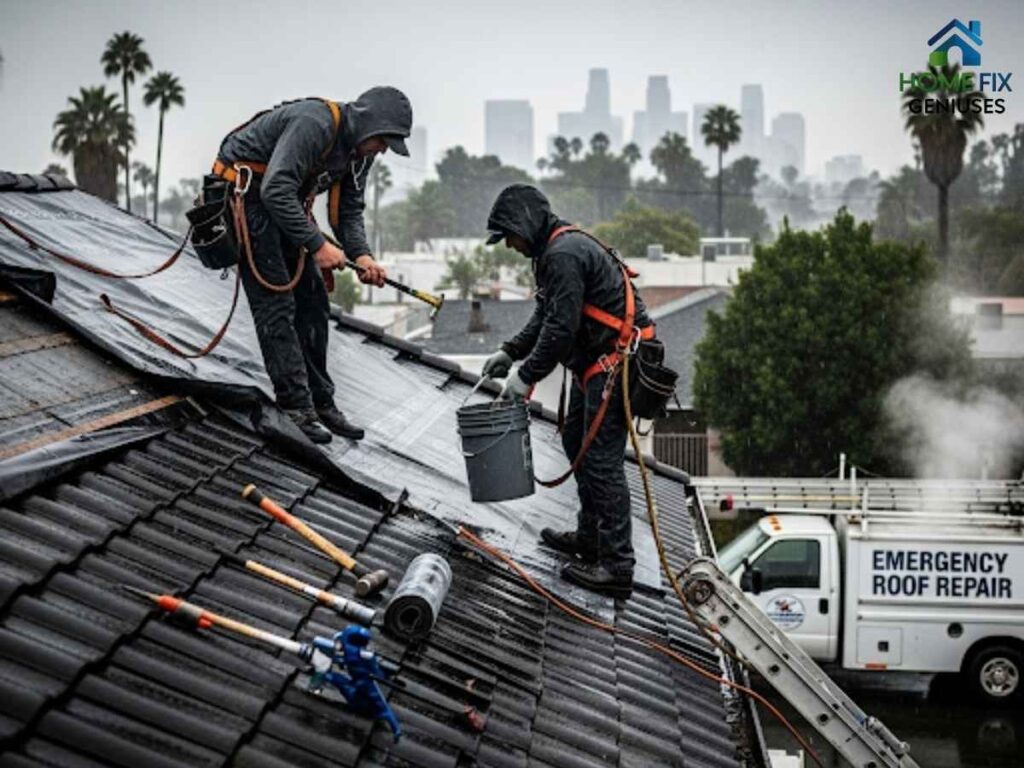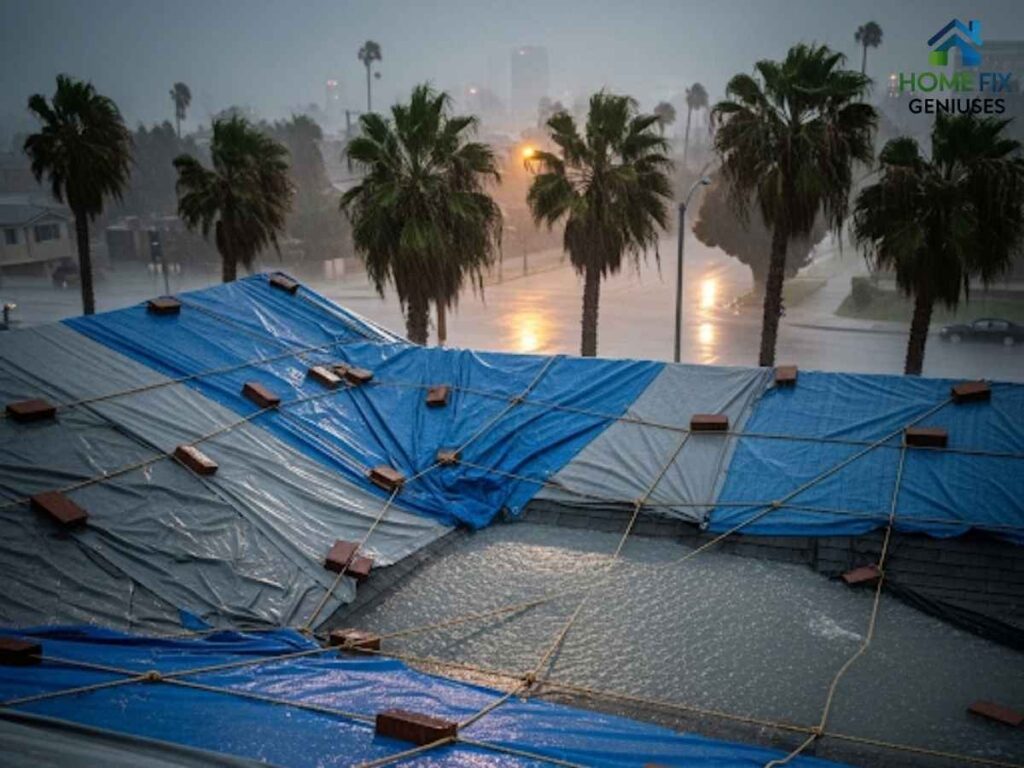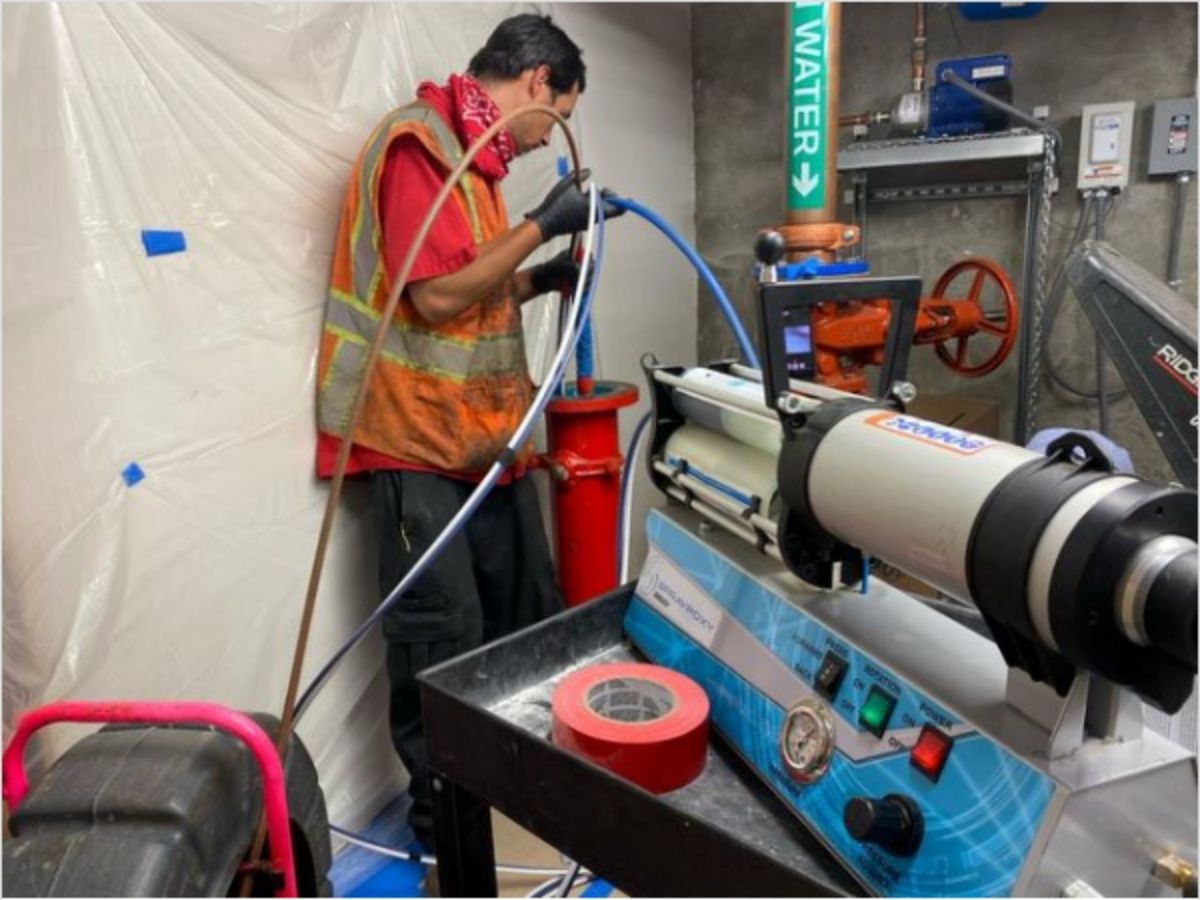When cold winter rain pounds Los Angeles, from Highland Park to Venice, few things are more stressful than discovering a steady drip making its way into your living room at midnight. You’re not alone—thousands of Angelenos each season face emergency roof leaks, and knowing exactly what to do during those anxious moments can prevent costly water damage and keep your home safe and dry.
Table of Contents
Los Angeles Winter Rains: The Unexpected Urban Challenge
Los Angeles is world-famous for its sunny skies, but winter can bring weeks of brisk, soaking rain, especially between December and March. In neighborhoods like Silver Lake (90026) and South LA (90007), modest homes and historic bungalows are often tested by storms. While the city averages just under 15 inches of annual rainfall, the majority falls during these cooler months, with some storms seeing up to 3.5 inches in just a few days.

Many LA roofs weren’t built for heavy, sustained rain. Flat roofs typical of mid-century houses in Sherman Oaks or tar-and-gravel coverings in East Hollywood can develop cracks, holes, and worn seals. Add constant sun exposure throughout the year, and materials age quickly, making leaks even more likely when the first winter deluge arrives.
Common Roof Leak Causes Across LA Neighborhoods
Every LA neighborhood—from bustling Downtown lofts to peaceful Westwood single-family homes—faces unique weatherproofing challenges. Leaks tend to appear at:
- Sun-damaged roofing materials (especially on south and west-facing slopes)
- Cracked, worn, or missing shingles on older homes
- Damaged flashing around chimneys, skylights, or vents
- Clogged gutters and drains, causing ponding on flat roofs
- Gaps created by poor installation or aging seams
Even new construction isn’t immune, especially with shifting temperatures and the “Pineapple Express” storms that sometimes drench the region.
What To Do When Rainwater Starts Dripping In
When you spot a leak, quick action is crucial. Here’s an LA-savvy, step-by-step guide you can use right now:
- Contain the Leak: Place buckets or pans directly under the drip. Line the area with towels. If the ceiling bulges, carefully puncture with a screwdriver to prevent the water from spreading.
- Protect Valuables: Move electronic equipment, rugs, and furniture away from the wet area. Use plastic sheeting or tarps to cover large items that can’t be moved.
- Create Temporary Protection: If it’s safe (and not actively raining), place a heavy-duty tarp over the suspected source outside. Secure it with bricks, heavy objects, or even sandbags—especially recommended for flat roofs typical in LA’s Miracle Mile.
- Dry Out ASAP: Run fans or a dehumidifier in the affected room. Mold can start in less than 24 hours, so act quickly, especially in enclosed areas like attics.
- Call a Professional: If water is getting inside during a storm, odds are a DIY fix won’t hold through LA’s unpredictable next downpour. Reach out to a local, 24/7 emergency roofing specialist.
Three LA Case Studies: Fast Response, Real Relief
Case Study 1: Eagle Rock Bungalow, 90041
Late January storms left a family’s 1920s Craftsman with steady drips flooding the living room. Emergency tarping was applied, minimizing interior damage. Crews found failed flashing around a chimney, common in older homes with double brick. The family’s proactive call saved their original hardwood floors.
Case Study 2: Mid-City Apartment Complex, 90016
Rain pooled on a flat roof above a third-floor unit, eventually leaking into bedrooms. The on-call property manager called a roof leak specialist. Within two hours, temporary repairs were made. Follow-up inspection revealed blocked drains and sun-baked membrane cracks. The HOA coordinated quick, targeted repairs for lasting protection.
Case Study 3: Westchester Family Home, 90045
During a February downpour, water began seeping through a garage’s ceiling. The homeowner used LA’s emergency payroll to find a certified roofer, who arrived that afternoon. A missing shingle and stray nail puncture were quickly patched with heavy-duty sealant. Records from the repairs made it easy for the owner to claim an LADWP rebate on subsequent cool roof upgrades.
The Top 3 Emergency Roof Leak Services in Los Angeles
1. Central Roof Company
With a dedicated emergency crew and decades of expertise, Central Roof Company offers 24-hour response and direct experience with LA’s varied roofing systems (www.centralroof.com/emergency-roof-repair/).
2. Bumble Roofing Los Angeles
Known for lightning-fast response and clear estimates, Bumble Roofing specializes in both residential and commercial properties—plus real-time updates and emergency tarping when every minute counts (bumbleroofing.com/los-angeles/roofing-service/emergency-services).
3. Roof Titan
Yelp’s top-rated local favorite, Roof Titan is trusted for advanced leak detection, comprehensive repairs, and respectful treatment of LA’s historic and contemporary homes alike. Free estimates and longtime community involvement make them a go-to choice (www.rooftitan.com/reliable-expert-roof-repair-services-in-los-angeles/).

Note: Always check California contractor licensing before hiring. LA offers online permit tools via the LA County Public Works portal at pw.lacounty.gov/general/faq/index.cfm, ensuring all repairs are safe and code-compliant.
Neighborhood-Specific Solutions
Depending on where you live, you may benefit from different emergency leak response tactics:
- Hancock Park (90020): Many homes with slate or clay tile roofs develop leaks at flashing joints or valleys. Professional repair using matching materials preserves historic charm and value.
- Venice (90291): Salt air and coastal storms can erode roof coatings faster. Applying a high-quality elastomeric sealant extends your roof life between storms.
- Glassell Park (90065): Hillside homes often suffer from windblown debris and branch punctures. Emergency tarping and quick debris clearance keep water out until a permanent fix.
Local Tools, Rebates, and Resources to Reduce Leak Stress
- LADWP Cool Roof Rebates: Homeowners who upgrade to an energy-efficient, leak-resistant cool roof can earn up to $0.60 per square foot. Check eligibility and apply through www.ladwp.com/residential-services/assistance-programs/consumer-rebate-program.
- LA County Permit Portal: Major roof repairs often require a permit. Start your application or check code compliance at pw.lacounty.gov/general/faq/index.cfm.
- Local Industry Associations: Join the Roofing Contractors Association of California for vetted pros and educational material (www.rcacalifornia.org).
- Water Damage Prevention Tips: Always keep gutters clear, especially before forecast storms. Schedule bi-annual professional inspections.
- Emergency Contact List: Store the numbers of at least two local roofers, your insurance agent, and the City of Los Angeles Building & Safety (ladbs.org) for rapid coordination when leaks occur.
What Angelenos Ask Most—Answered
How much does emergency roof leak repair cost in Los Angeles?
Pricing varies by roof type and severity, but emergency services start around $400 for basic tarping and patching. Major repairs or replacements, especially in historic homes, may run $1,000–$5,000+. Always get a clear written estimate before work begins.
Do I need a permit for emergency roof repairs in LA?
Minor, temporary repairs (like tarping) don’t require a permit, but anything permanent— replacing shingles, sheathing, or repairing structural elements—almost always does. You can apply for swift permits online via LA County’s Building and Safety portal.
Can tenants get repairs for roof leaks if a landlord won’t act?
Yes. In LA, tenants are entitled to safe, weatherproof homes. If a landlord delays, tenants may hire a licensed roofer for emergency fixes and deduct reasonable costs from rent, per city code. Keep all documentation and notify your landlord in writing.
What neighborhoods are most prone to winter roof leaks?
Areas with many older homes, such as Echo Park, Silver Lake, and West Adams, often experience more problems. Hillside neighborhoods may see more wind-driven leaks, and coastal zones can face salt-induced deterioration.
How fast do emergency roofers respond during storms?
During major rains, many LA roofers offer 24/7 emergency dispatches. Response times are fastest for longstanding local customers or those in central ZIP codes, though high demand during “atmospheric rivers” may cause temporary delays.


